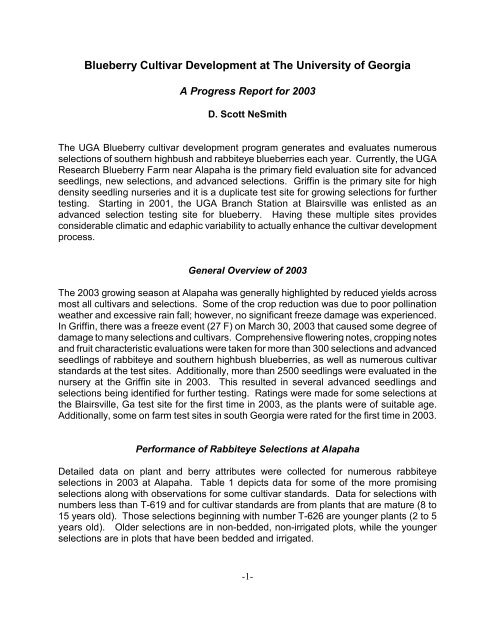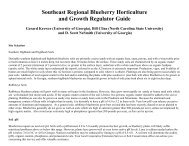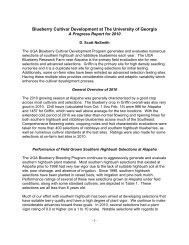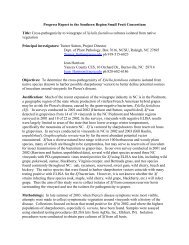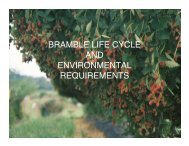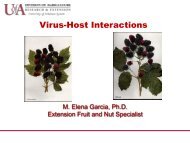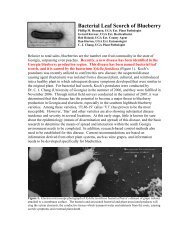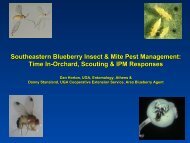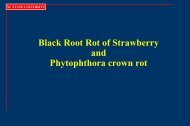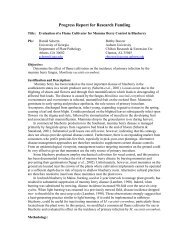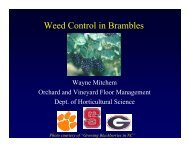Blueberry Cultivar Development at The University of Georgia
Blueberry Cultivar Development at The University of Georgia
Blueberry Cultivar Development at The University of Georgia
Create successful ePaper yourself
Turn your PDF publications into a flip-book with our unique Google optimized e-Paper software.
<strong>Blueberry</strong> <strong>Cultivar</strong> <strong>Development</strong> <strong>at</strong> <strong>The</strong> <strong>University</strong> <strong>of</strong> <strong>Georgia</strong>A Progress Report for 2003D. Scott NeSmith<strong>The</strong> UGA <strong>Blueberry</strong> cultivar development program gener<strong>at</strong>es and evalu<strong>at</strong>es numerousselections <strong>of</strong> southern highbush and rabbiteye blueberries each year. Currently, the UGAResearch <strong>Blueberry</strong> Farm near Alapaha is the primary field evalu<strong>at</strong>ion site for advancedseedlings, new selections, and advanced selections. Griffin is the primary site for highdensity seedling nurseries and it is a duplic<strong>at</strong>e test site for growing selections for furthertesting. Starting in 2001, the UGA Branch St<strong>at</strong>ion <strong>at</strong> Blairsville was enlisted as anadvanced selection testing site for blueberry. Having these multiple sites providesconsiderable clim<strong>at</strong>ic and edaphic variability to actually enhance the cultivar developmentprocess.General Overview <strong>of</strong> 2003<strong>The</strong> 2003 growing season <strong>at</strong> Alapaha was generally highlighted by reduced yields acrossmost all cultivars and selections. Some <strong>of</strong> the crop reduction was due to poor pollin<strong>at</strong>ionwe<strong>at</strong>her and excessive rain fall; however, no significant freeze damage was experienced.In Griffin, there was a freeze event (27 F) on March 30, 2003 th<strong>at</strong> caused some degree <strong>of</strong>damage to many selections and cultivars. Comprehensive flowering notes, cropping notesand fruit characteristic evalu<strong>at</strong>ions were taken for more than 300 selections and advancedseedlings <strong>of</strong> rabbiteye and southern highbush blueberries, as well as numerous cultivarstandards <strong>at</strong> the test sites. Additionally, more than 2500 seedlings were evalu<strong>at</strong>ed in thenursery <strong>at</strong> the Griffin site in 2003. This resulted in several advanced seedlings andselections being identified for further testing. R<strong>at</strong>ings were made for some selections <strong>at</strong>the Blairsville, Ga test site for the first time in 2003, as the plants were <strong>of</strong> suitable age.Additionally, some on farm test sites in south <strong>Georgia</strong> were r<strong>at</strong>ed for the first time in 2003.Performance <strong>of</strong> Rabbiteye Selections <strong>at</strong> AlapahaDetailed d<strong>at</strong>a on plant and berry <strong>at</strong>tributes were collected for numerous rabbiteyeselections in 2003 <strong>at</strong> Alapaha. Table 1 depicts d<strong>at</strong>a for some <strong>of</strong> the more promisingselections along with observ<strong>at</strong>ions for some cultivar standards. D<strong>at</strong>a for selections withnumbers less than T-619 and for cultivar standards are from plants th<strong>at</strong> are m<strong>at</strong>ure (8 to15 years old). Those selections beginning with number T-626 are younger plants (2 to 5years old). Older selections are in non-bedded, non-irrig<strong>at</strong>ed plots, while the youngerselections are in plots th<strong>at</strong> have been bedded and irrig<strong>at</strong>ed.-1-
With rabbiteyes, we continue to be interested in early ripening selections to replace Climax.Climax had 50% ripening by May 31 this year, however, as in many other years the cropload <strong>of</strong> Climax was low (only 3.5 on a 1 to 10 scale). <strong>The</strong> new UGA release ‘Alapaha’continues to perform well, having a ripening d<strong>at</strong>e similar to Climax, but with a much bettercrop load. Another outstanding early season rabbiteye selection is T-584. It too ripenswith Climax, yet generally has a better crop load and bigger berry size. More detailed d<strong>at</strong>aon T-584 are presented in other sections <strong>of</strong> this report. This selection is under strongconsider<strong>at</strong>ion for release in 2004. T-366 is a selection <strong>of</strong> interest due to its nominal cropload and early ripening d<strong>at</strong>e (May 26), however, berry size <strong>of</strong> the selection is small. T-541,T-611, and T-616 all had ripening d<strong>at</strong>es earlier than Climax. Of these, T-616 had the bestcrop load and the largest berry size, and the selection was noted as being a rabbiteye withvery smooth berry texture, having few seeds. Of the younger rabbiteye m<strong>at</strong>erial, T-655was <strong>of</strong> gre<strong>at</strong> interest due to its early ripening d<strong>at</strong>e and tremendous berry size (9.5 on a 1to 10 scale). Propag<strong>at</strong>ions <strong>of</strong> T-616 and T-655 were made to conduct more advancedtests <strong>at</strong> multiple sites.As for mid-season ripening berries, Brightwell continues to be the standard for testing.Brightwell ripened a bit earlier than usual in 2003 (June 9), and had a fair crop load.Several selections ripened with Brightwell or a bit earlier. Selections in the Brightwellseason worth noting are T-538, T-619, T-626, and T-672. Of these, T-538 has very goodberry size, T-619 has good berry color and scar, and T-672 has outstanding berry firmness.Some <strong>of</strong> these selections have been propag<strong>at</strong>ed for further testing.As for the Tifblue ripening season, there are only a few selections we are looking <strong>at</strong>. Ofthese, T-459 is the most promising. This selection generally has a good crop, and berrysize is really large compared to Tifblue. <strong>The</strong> berry size <strong>of</strong> T-459 is generally maintainedacross all harvests, which again makes it a desirable selection. We continue to haveinterest in T-300 due to its outstanding berry size, but additional testing is needed to betterassess performance. <strong>The</strong> plant type <strong>of</strong> T-300 is somewh<strong>at</strong> compact, and slow growing.‘Ochlockonee’ (released in 2002), performed well again in 2003. <strong>The</strong> new releasecontinues to ripen l<strong>at</strong>er than Tifblue, and would provide a l<strong>at</strong>e season, high producingvariety for those with interest in th<strong>at</strong> ripening season.Other rabbiteye selections worth noting for their large berry size are T-451, T-460, and T-675. We continue to exam T-451 as a potential release. Positive <strong>at</strong>tributes for theselection are th<strong>at</strong> it has an early ripening, very large berry; neg<strong>at</strong>ives are th<strong>at</strong> it generallyflowers early resulting in a low crop load, and it has a gre<strong>at</strong> tendency for fruit splitting in wetwe<strong>at</strong>her. In addition to favorable berry size, T-460 generally has a very good crop load,good berry color, and good plant vigor. In some years however, the ripening <strong>of</strong> T-460 hasbeen too drawn out. T-675 is a very young selection with exciting potential. It has bothvery good berry size and firmness.-2-
Performance <strong>of</strong> Rabbiteye Selections <strong>at</strong> GriffinMany <strong>of</strong> the rabbiteye selections listed above for the Alapaha loc<strong>at</strong>ion also performed well<strong>at</strong> the Griffin test site (Table 2). All plants <strong>at</strong> the Griffin test site are young (5 years old orless), and all plants are irrig<strong>at</strong>ed and mulched with bark. In Griffin, Climax ripened on June21. Again, the new release ‘Alapaha’ performed well in comparison to Climax, as did theselection T-584. Other selections ripening before Climax in Griffin were T-366, T-626, T-630, and T-655. Although T-366 ripened earlier than Climax in Griffin, the selection stillhas a problem with berry size. T-630 is a selection th<strong>at</strong> has performed well in Griffin overthe past couple <strong>of</strong> years, especially with regards to crop load. However, the selection hasperformed only moder<strong>at</strong>ely well in south <strong>Georgia</strong>. T-626 had the gre<strong>at</strong>est crop load <strong>of</strong> allrabbiteye selections in Griffin, and ripened 3 days earlier than Climax and 10 days earlierthan Brightwell. We will continue to evalu<strong>at</strong>e this selection <strong>at</strong> both Griffin and Alapaha.Those selections having good berry size in Griffin were T-451, T-459, T-655, T-672, andT-675. Most <strong>of</strong> these selections were those with good berry size <strong>at</strong> the Alapaha test siteas well.Multi-year Yields <strong>of</strong> Advanced Rabbiteye Selections <strong>at</strong> AlapahaYields have been taken for several rabbiteye selections and cultivar standards <strong>at</strong> theAlapaha test site since 1998 (Table 3). When considering the early season, Climax yieldhas been inferior to the new release ‘Alapaha’ and to the selections T-451 and T-584. Asmentioned previously, T-584 is under strong consider<strong>at</strong>ion for release in 2004. <strong>The</strong> 6-yearaverage yields for this selection are nearly twice th<strong>at</strong> <strong>of</strong> Climax. As for T-451, the 6-yearaverage yields are nearly triple th<strong>at</strong> <strong>of</strong> Climax. <strong>The</strong> large berry size <strong>of</strong> this selection tendsto give high total yields even when cropping is low. However, the selection is plagued bya fruit splitting problem. T-451 is being considered for release in 2004 or 2005, but thecommercial potential may be limited. However, the selection should make an outstandingvariety for the homeowner and smaller, pick-your-own grower due to its tremendous berrysize.In the mid season, T-431 has been a selection we have scrutinized for several years as apotential cultivar. <strong>The</strong> yield d<strong>at</strong>a suggest th<strong>at</strong> the selection has been equal to Brightwellover a 6 year period in south <strong>Georgia</strong>. <strong>The</strong> older plants <strong>of</strong> this selection have continuedto perform well, however, younger plantings <strong>of</strong> the selection have been slow to beginproduction. Due to this problem, we have abandoned the release <strong>of</strong> this selection for thetime being.In the l<strong>at</strong>er season, ‘Ochlockonee’ continues to outperform Tifblue, although the newrelease does ripen 7 days l<strong>at</strong>er than the standard cultivar. T-459 continues to perform wellfor a l<strong>at</strong>er season selection, and again, it has a very favorable berry size across multipleharvests. We are considering it for release in the next couple <strong>of</strong> years.-3-
Multi-loc<strong>at</strong>ion Yields and Performance <strong>of</strong> Advanced Rabbiteye SelectionsIn addition to the multi-year yield d<strong>at</strong>a from Alapaha, in 2003 we were able to collect yieldand performance d<strong>at</strong>a for three advanced selections <strong>at</strong> three diverse test sites (Table 4).Chill hours (calcul<strong>at</strong>ed from Oct. 1 thru Feb. 15) <strong>at</strong> the loc<strong>at</strong>ions in 2003 were as follows:Blairsville had 1800 to 1850; Griffin had 1340 to 1390; Alapaha had 900 to 950. Plants<strong>at</strong> Alapaha were m<strong>at</strong>ure plants (more than 10 years old); whereas, plants <strong>at</strong> Griffin andBlairsville were generally very young (only 2 years old), except for the Tifblue and T-459plants in Griffin, which were 4 years old. Bloom d<strong>at</strong>es in Griffin were generally 8 to 14 daysl<strong>at</strong>er for a particular selection than <strong>at</strong> Alapaha, and Blairsville bloom d<strong>at</strong>es were generally2 to 3 weeks l<strong>at</strong>er than in Griffin. Bloom d<strong>at</strong>e ranking was similar <strong>at</strong> the loc<strong>at</strong>ions, exceptfor T-451. T-451 is one <strong>of</strong> the earlier blooming selections in south <strong>Georgia</strong>, but it wasamong the l<strong>at</strong>er blooming ones in middle and north <strong>Georgia</strong>. T-584 generally bloomed aweek l<strong>at</strong>er than Climax <strong>at</strong> all loc<strong>at</strong>ions, but ripened with the standard cultivar. Thisresponse <strong>of</strong> T-584 indic<strong>at</strong>es it would be a better early season choice due to the fact th<strong>at</strong>it blooms l<strong>at</strong>er, thus missing some early season freeze events th<strong>at</strong> would harm Climax.<strong>The</strong> further north we went, the closer ripening d<strong>at</strong>es for Brightwell and Climax were. Asimilar trend was observed for Tifblue and T-459.T-584 performed well across the environments, yielding more than Climax <strong>at</strong> two <strong>of</strong> theloc<strong>at</strong>ions. This is additional evidence th<strong>at</strong> the selection would make a good cultivar. T-459tended to have similar yield to th<strong>at</strong> <strong>of</strong> Tifblue across loc<strong>at</strong>ions, but again, berry size is morefavorable for T-459. Berry size <strong>of</strong> T-451 was very large across all loc<strong>at</strong>ions, and berry size<strong>of</strong> T-459 was large to very large. Climax berries were very small in south <strong>Georgia</strong>, but sizebecame more favorable as we moved north. Berry size <strong>of</strong> all selections was generallygre<strong>at</strong>est in the cooler mountain loc<strong>at</strong>ion <strong>of</strong> Blairsville.<strong>The</strong> d<strong>at</strong>a from the multi-loc<strong>at</strong>ion tests are very valuable in determining the adaptability <strong>of</strong>selections across environments. We will continue to monitor these selections <strong>at</strong> theloc<strong>at</strong>ions for a few more years, and we will add new plantings <strong>of</strong> selections to the varioussites.Performance <strong>of</strong> Southern Highbush Selections <strong>at</strong> Alapaha<strong>The</strong> UGA <strong>Blueberry</strong> Breeding Program continues to aggressively gener<strong>at</strong>e and evalu<strong>at</strong>esouthern highbush plant m<strong>at</strong>erial. Most southern highbush selections th<strong>at</strong> existed <strong>at</strong>Alapaha prior to 1998 had very low vigor due to the lack <strong>of</strong> suitable highbush soil <strong>at</strong> thesite, poor drainage, and absence <strong>of</strong> irrig<strong>at</strong>ion. <strong>The</strong> exception was the selection TH-471,which has proved to have a nominal level <strong>of</strong> vigor. This selection was submitted forrelease in 2003, and additional d<strong>at</strong>a concerning this is presented l<strong>at</strong>er in the report.Since 1998, southern highbush selections have been planted in raised beds, with irrig<strong>at</strong>ionand pine bark mulch. Performance <strong>of</strong> several <strong>of</strong> these new selections <strong>at</strong> Alapaha, along-4-
with some standard cultivars, is depicted in Table 5. <strong>The</strong>se selections are all less than 5years old, except for <strong>Georgia</strong>gem and TH-471.Highbush selections beginning with the number TH-642 and l<strong>at</strong>er are those th<strong>at</strong> haveresulted from crosses we made <strong>at</strong> UGA. Much <strong>of</strong> our effort has been aimed <strong>at</strong> developingsouthern highbush th<strong>at</strong> have quality berry <strong>at</strong>tributes and a high degree <strong>of</strong> plant vigor. InTable 5, the results suggest th<strong>at</strong> we are making considerable advances toward thesegoals. Numerous selections have a vigor r<strong>at</strong>ing <strong>of</strong> 8.0 or higher (on a 1 to 10 scale).Notable selections are TH-621, TH-622, TH-647, TH-654, TH-656, and TH-685. Of these,TH-654 has the gre<strong>at</strong>est plant vigor; however, the selection is deficient with regards toberry firmness. TH-621 and TH-622 have a high degree <strong>of</strong> plant vigor, and have very goodberry quality. However, these selections tend to ripen l<strong>at</strong>e for the south <strong>Georgia</strong> southernhighbush market. We are anxious to determine if these selections have interest amonggrowers for a vigorous, high quality berry, th<strong>at</strong> ripens just before the rabbiteye season.Early ripening continues to be a property <strong>of</strong> southern highbush th<strong>at</strong> appeals to many south<strong>Georgia</strong> growers. <strong>The</strong> Florida release ‘Star’ is currently a prominent standard cultivar, andit had 50% ripe fruit by May 7 <strong>at</strong> Alapaha in 2003. Among the new selections, TH-642 isone <strong>of</strong> the more outstanding with regards to early ripening (50% ripe on May 3), and it hasvery good berry size, crop load, and plant vigor. We have propag<strong>at</strong>ed this selection forfurther testing. Other selections th<strong>at</strong> ripen near the time <strong>of</strong> ‘Star’ are TH-471 (to bediscussed l<strong>at</strong>er), TH-644, and TH-647. Many <strong>of</strong> the selections ripen 5 to 8 days after ‘Star’.Of these, the selection TH-653 was the most notable, having large fruit size, excellentfirmness, and better than average cropping and vigor. We have several highbushselections with excellent fruit color (TH-621, TH-622, TH-681, TH-683, TH-691), and somewith outstanding firmness (TH-661, TH-663, TH-680). We will need to evalu<strong>at</strong>e theseselections for 3 to 5 more years in order to identify those th<strong>at</strong> are suitable as cultivars.Performance <strong>of</strong> Southern Highbush Selections <strong>at</strong> GriffinAll <strong>of</strong> the southern highbush plants growing in Griffin are 4 years old or less. While the testsite is not considered very suitable for southern highbush production, we have been ableto grow several <strong>of</strong> our selections in the red Piedmont soil with pine bark mulch andirrig<strong>at</strong>ion. Table 6 lists d<strong>at</strong>a for several <strong>of</strong> the highbush selections in Griffin. Some <strong>of</strong> thesewere evalu<strong>at</strong>ed <strong>at</strong> Alapaha as well. Again, we have selections th<strong>at</strong> demonstr<strong>at</strong>eoutstanding plant vigor, including TH-664, TH-667, and TH-668. Of these, TH-667 is themost notable as it also had large berry size, a good crop load, and a ripening d<strong>at</strong>e as earlyas Star. TH-642, one <strong>of</strong> the prominent selections in south <strong>Georgia</strong>, had a ripening d<strong>at</strong>e 9days earlier than Star in Griffin.One <strong>of</strong> the most noteworthy highbush selections in Griffin during 2003 was TH-658. Thisselection had the highest firmness r<strong>at</strong>ing possible, and also had good berry size and aboveaverage plant vigor. In Griffin, TH-658 bloomed 10 days l<strong>at</strong>er than Star, yet ripened aweek earlier. <strong>The</strong> selection will be closely monitored <strong>at</strong> both Griffin and Alapaha over the-5-
next 3 to 5 years to determine its suitability as a cultivar. We have also propag<strong>at</strong>ed alimited number <strong>of</strong> plants to test <strong>at</strong> additional loc<strong>at</strong>ions.Performance <strong>of</strong> Southern Highbush Selections in A High Density SystemSome <strong>Georgia</strong> growers are interested in growing southern highbush blueberries in highdensity production systems. To d<strong>at</strong>e, there has been little or no compar<strong>at</strong>ive inform<strong>at</strong>ionon how different southern highbush selections and cultivars perform in such a system. In2002, we established a high density test site <strong>at</strong> Alapaha consisting <strong>of</strong> several leadingcultivars and some <strong>of</strong> the new UGA selections. This site consists <strong>of</strong> raised beds filled withbark, overhead irrig<strong>at</strong>ion, bird netting, and a plant spacing <strong>of</strong> 3 ft. x 5 ft. Table 7 presentsperformance d<strong>at</strong>a for the various selections during 2003, which was the first croppingseason. Generally all selections and cultivars had suitable plant vigor in this system, theone exception being th<strong>at</strong> Star plants were a little weak. Two <strong>of</strong> the most important pieces<strong>of</strong> d<strong>at</strong>a for this system are the ripening d<strong>at</strong>e and crop load for the various entries, asgrowers need to maximize returns. Emerald had one <strong>of</strong> the best crop loads, but severalselections had earlier ripening fruit. TH-658 was a notable selection th<strong>at</strong> ripened early(May 7), had outstanding berry firmness, and produced nearly half a crop. <strong>The</strong> cultivarWindsor had a decent crop load, but the ripening time was very l<strong>at</strong>e (May 28). It appearsplants having berries th<strong>at</strong> ripen May 15 or earlier would be those to be considered for highdensity production. Possible candid<strong>at</strong>es are Emerald, Star, and O’neal, with respect toexisting cultivars, and TH-471, TH-649, TH-656, TH-658, and TH-663 with respect to newselections. We will evalu<strong>at</strong>e the plants in this setting again next year in order to providemore decision making inform<strong>at</strong>ion.Performance <strong>of</strong> a New Southern Highbush ReleaseAfter several years <strong>of</strong> testing, we have submitted the selection TH-471 to be approved forrelease in 2003. If approved, the planned name for the new cultivar is ‘Palmetto’. Wehave compared TH-471 with several southern highbush cultivars for the past 5 years.Table 8 portrays yield for TH-471, along with <strong>Georgia</strong>gem and Sharpblue. <strong>The</strong>se d<strong>at</strong>a arefrom plants th<strong>at</strong> were established <strong>at</strong> Alapaha in 1992, without bedding, irrig<strong>at</strong>ion or soilamendment. ‘<strong>Georgia</strong>gem’ has yielded no fruit during the first week in May, whereas, TH-471 yielded more th<strong>at</strong> 35% <strong>of</strong> its fruit during th<strong>at</strong> time period on average. When the first2 weeks <strong>of</strong> May are considered, TH-471 ripened more than 75% <strong>of</strong> its fruit during th<strong>at</strong> timeon average, compared to only 38% and 51% for ‘<strong>Georgia</strong>gem’ and ‘Sharpblue’,respectively. TH-471 yields overall were twice th<strong>at</strong> <strong>of</strong> ‘<strong>Georgia</strong>gem’ for the 5 year average.Table 9 portrays average berry <strong>at</strong>tributes and plant vigor for TH-471 and 4 other southernhighbush blueberry selections grown <strong>at</strong> Alapaha, Ga. over a 6 year period. TH-471exceeded all <strong>of</strong> the cultivars with respect to berry scar, berry firmness, and plant vigor. Forother berry <strong>at</strong>tributes, TH-471 was generally similar to the various cultivars, except for berry-6-
size, which was smaller (but commercially acceptable). Thus, TH-471 has good toexcellent fruit quality, and outstanding plant vigor.Flowering and ripening times are important d<strong>at</strong>a for growers who are considering producingsouthern highbush blueberries. Generally, the early flowering times require frost protectionmeasures, and growers want the ripening times to be early enough to <strong>of</strong>fer a “high pricereward” for the risk they encounter. Table 9 lists flowering and ripening d<strong>at</strong>es for TH-471and 3 southern highbush cultivars <strong>at</strong> Alapaha, Ga. over a 6 year period. <strong>The</strong> floweringtimes <strong>of</strong> all <strong>of</strong> the selections (l<strong>at</strong>e February to early March) are early, yet, TH-471 generallyripens the earliest.As for adaptability to other areas, TH-471 seems to be as adaptable as the popular cultivar‘Star’ (released by Florida in 1996). Table 10 depicts fruit and plant characteristics <strong>of</strong> TH-471 and ‘Star’ for 2 to 4 year-old plants <strong>at</strong> 3 loc<strong>at</strong>ions in <strong>Georgia</strong> and one loc<strong>at</strong>ion inMississippi during 2003. <strong>The</strong> two entries generally ripened <strong>at</strong> the same time, and hadsimilar <strong>at</strong>tributes. <strong>The</strong> exceptions were th<strong>at</strong> TH-471 had firmer fruit than ‘Star’, andtypically had a better cropping score also.Plans are being made to have TH-471 plant m<strong>at</strong>erial available for propag<strong>at</strong>ors by February2004, assuming the release is approved. In order to obtain a license for propag<strong>at</strong>ing‘Palmetto’ and other UGA blueberry cultivars, contact the <strong>Georgia</strong> Seed <strong>Development</strong>Commission in Athens (ph. 706-542-5640).Goals <strong>of</strong> <strong>The</strong> UGA <strong>Blueberry</strong> <strong>Cultivar</strong> <strong>Development</strong> Program for 2004Plans for the year 2004 are to continue aggressively evalu<strong>at</strong>ing seedlings, advancedseedlings, selections, and advanced selections <strong>of</strong> both rabbiteye and southern highbushblueberries. More than 30 new crosses (yielding 50 to 300 seedlings per cross) <strong>of</strong>rabbiteye and southern highbush will be made during 2004. Nearly 2500 seedlings weregener<strong>at</strong>ed from crosses made in 2003. <strong>The</strong>se seedlings will be planted in a seedlingnursery during the early summer <strong>of</strong> 2004 to be grown for future evalu<strong>at</strong>ions. More than5000 seedlings were planted in nurseries during 2002 and 2003, and these seedlings willbe screened during 2004 for fruit characteristics including size, scar, firmness, color, andflavor. <strong>The</strong> most promising seedlings will be identified as advanced seedlings for furtherevalu<strong>at</strong>ion (estim<strong>at</strong>ed to be 2 to 3% <strong>of</strong> total seedlings). In 2003, over 90 seedlings wereidentified as advanced seedlings from 2001 crosses. <strong>The</strong>se advanced seedlings will beplanted in the field <strong>at</strong> Alapaha, and will be further evalu<strong>at</strong>ed as potential selections in2004. In addition to the advanced seedlings from 2003, more than 60 new selections weremade from seedlings <strong>of</strong> crosses made by the UGA program in the last 2 years. <strong>The</strong>sewere propag<strong>at</strong>ed, and multiple plants will be established <strong>at</strong> Alapaha and Griffin in 2004 forreplic<strong>at</strong>ed evalu<strong>at</strong>ions. <strong>The</strong>se new selections will be added to the more than 200selections currently growing <strong>at</strong> these loc<strong>at</strong>ions, and all will be evalu<strong>at</strong>ed during 2004 forpossible design<strong>at</strong>ion as advanced selections.-7-
In 2003, several selections were identified as advanced selections and were propag<strong>at</strong>ed.<strong>The</strong>se will be further evalu<strong>at</strong>ed in 2004 for potential as cultivars, and some <strong>of</strong> the advancedselections will be distributed to cooper<strong>at</strong>ors to assist in the evalu<strong>at</strong>ion process. Severalrabbiteye and southern highbush advanced selections were distributed to growercooper<strong>at</strong>orsin 2002 and 2003 to begin the final phase <strong>of</strong> testing for their potential ascultivar releases. Furthermore in 2004, 4 to 6 advanced selections from the UGA programwill be entered into a Southern Regional <strong>Blueberry</strong> Trial along with standard cultivars andselections from other breeding programs. Plantings <strong>of</strong> these selections will be made in<strong>Georgia</strong>, Florida, Mississippi, North Carolina, and Arkansas. D<strong>at</strong>a from these trials will becollected beginning in 2006 and will continue through 2009. Evalu<strong>at</strong>ions <strong>of</strong> theseadvanced selections will include fruit characteristics, plant growth characteristics, floweringtimes, and yields. A similar Southern Region Trial was established with other selectionsin 2001, and d<strong>at</strong>a were collected from this trial for the first time in 2003. <strong>The</strong>se trials willcontinue thru 2005.-8-
Table 1. R<strong>at</strong>ings (1 to 10 scale) <strong>of</strong> some fruit and plant characteristics <strong>of</strong> rabbiteyeblueberry cultivars and selections from the <strong>Blueberry</strong> <strong>Cultivar</strong> <strong>Development</strong> Program <strong>at</strong> theAlapaha, GA loc<strong>at</strong>ion during 2003. A value <strong>of</strong> 7 is generally considered to be the minimumacceptable r<strong>at</strong>ing for a commercial cultivar.Selection orVarietyD<strong>at</strong>e <strong>of</strong>50%FloweringD<strong>at</strong>e <strong>of</strong>50%RipeningBerrySizeBerryScarBerryColorBerryFirmnessBerryFlavorCropLoadPlantvigorAlapaha --- May 31 7.5 8.5 7.5 8.0 8.0 7.5 8.5Brightwell March 21 June 9 8.0 8.5 8.0 8.5 8.0 7.0 8.5Climax March 14 May 31 7.5 8.5 8.0 8.5 8.0 3.5 8.5Ochlockonee March 24 June 28 7.5 8.5 8.5 8.0 8.5 8.5 9.5Tifblue March 21 June 17 7.0 8.5 8.5 8.0 8.0 7.0 9.5T-300 March 24 June 15 9.0 9.0 7.0 8.5 7.0 7.0 7.5T-366 --- May 26 6.8 8.5 7.0 7.8 8.5 8.2 7.5T-431 March 20 June 8 8.5 8.5 9.0 8.0 8.0 6.0 8.5T-451 March 15 June 8 9.5 8.5 7.5 8.0 7.5 4.0 9.5T-459 March 22 June 23 8.7 8.7 8.5 8.0 8.3 7.5 8.2T-460 March 18 June 12 9.0 9.5 9.0 8.0 8.5 8.0 9.0T-516 March 23 June 12 8.3 7.5 9.0 7.0 8.0 7.8 8.5T-538 March 21 June 7 9.0 8.5 8.0 8.0 7.8 6.5 8.5T-541 --- May 21 7.5 8.5 7.0 8.0 9.0 3.5 8.0T-551 March 19 May 31 8.0 8.5 8.5 9.5 8.5 6.0 8.0T-584 March 20 May 31 8.0 9.0 7.5 8.5 7.0 5.0 9.0T-611 ---- May 25 8.0 8.0 8.0 7.8 7.3 5.8 8.0T-616 March 16 May 24 8.5 8.5 7.5 7.5 8.5 6.0 8.5T-618 March 11 May 31 8.5 8.5 8.5 7.5 7.5 7.5 9.0T-619 March 16 June 8 8.5 9.0 9.0 8.0 7.0 5.0 8.5T-626 March 7 June 9 7.5 9.0 8.5 8.5 8.0 5.0 9.5T-630 March 14 May 29 8.5 8.0 8.0 7.5 7.5 3.5 8.0T-655 March 19 May 31 9.5 9.5 8.0 8.0 7.0 6.5 8.0T-671 --- June 1 8.0 8.5 8.5 9.5 7.5 5.0 7.0T-672 --- June 6 8.0 8.5 8.0 9.0 7.5 6.5 8.0T-675 --- June 3 9.0 9.0 7.0 9.0 8.0 6.0 8.0-9-
Table 2. R<strong>at</strong>ings (1 to 10 scale) <strong>of</strong> some fruit and plant characteristics <strong>of</strong> rabbiteyeblueberry cultivars and selections from the <strong>Blueberry</strong> <strong>Cultivar</strong> <strong>Development</strong> Program <strong>at</strong> theGriffin, GA loc<strong>at</strong>ion during 2003. A value <strong>of</strong> 7 is generally considered to be the minimumacceptable r<strong>at</strong>ing for a commercial cultivar.Selection orVarietyD<strong>at</strong>e <strong>of</strong>50%FloweringD<strong>at</strong>e <strong>of</strong>50%RipeningBerrySizeBerryScarBerryColorBerryFirmnessBerryFlavorCropLoadPlantvigorAlapaha March 29 June 17 7.5 8.5 7.5 8.0 8.0 6.0 8.5Brightwell March 29 June 29 8.0 8.0 7.5 8.5 8.0 6.5 8.5Climax March 26 June 21 7.0 8.0 7.5 8.0 7.5 4.0 7.5Ochlockonee April 7 July 10 7.5 8.5 8.0 8.0 8.0 6.5 8.5Tifblue March 29 July 4 7.0 8.5 8.0 8.0 8.0 6.5 9.0T-300 March 29 July 1 8.0 8.0 7.0 8.5 7.0 4.0 7.5T-366 April 4 June 16 6.5 8.0 7.0 8.0 8.0 6.5 7.5T-431 March 30 June 21 8.5 8.5 9.0 8.0 8.0 3.5 8.0T-451 April 1 July 4 9.0 8.5 7.5 8.0 7.0 3.5 8.0T-459 March 31 July 3 8.5 8.5 8.0 8.0 8.0 5.0 7.5T-584 April 2 June 20 8.0 8.0 7.5 8.0 7.5 4.0 8.5T-626 March 25 June 18 7.5 9.0 8.5 8.5 8.0 8.5 9.0T-630 March 31 June 13 8.5 7.0 8.5 8.0 8.0 7.5 7.5T-655 March 26 June 19 9.0 8.5 7.5 8.0 8.0 6.0 7.5T-670 --- July 2 8.0 8.5 7.5 8.0 8.0 3.5 8.5T-672 April 5 June 29 9.0 8.5 7.5 9.0 8.0 6.5 8.0T-673 --- June 21 7.5 7.5 7.0 8.0 7.0 3.0 8.0T-674 --- June 25 8.0 8.0 8.0 8.0 7.0 3.5 7.5T-675 --- June 26 8.5 8.0 7.0 9.0 8.0 4.5 7.5-10-
Table 3. Total yield (lbs/bush) during 1998 thru 2003 <strong>of</strong> some early, mid, and l<strong>at</strong>e seasonrabbiteye blueberry selections and cultivar standards <strong>at</strong> <strong>The</strong> <strong>University</strong> <strong>of</strong> <strong>Georgia</strong> <strong>Blueberry</strong>Research Farm, Alapaha, Ga.Total yield per bush (lbs)<strong>Cultivar</strong> orselection1998 1999 2000 2001 2002 2003Early Season-11-multiyearavg.Climax 6.6 6.2 11.2 7.9 5.2 3.5 6.8Alapaha 11.5 Z/ 13.4 15.0 12.5 13.0 Z/ 14.0 Z/ 13.2T-451 8.6 Z/ 23.0 Z/ 23.2 23.8 14.0 10.7 17.2T-584 7.4 Z/ 13.4 14.0 22.5 13.0 6.6 12.8Mid SeasonBrightwell 13.0 6.8 13.1 20.2 11.4 8.9 12.2T-431 11.4 9.5 13.4 13.3 17.8 8.3 12.3L<strong>at</strong>e SeasonTifblue 6.3 3.1 17.5 16.8 6.7 5.8 9.4Ochlockonee 14.5 5.3 26.5 17.5 21.0 22.0 Z/ 17.8T-397 7.9 13.2 12.8 10.4 13.5 6.7 10.8T-459 8.8 14.3 16.8 10.1 17.3 9.0 12.7Z/ <strong>The</strong>se yields were estim<strong>at</strong>ed using cropping scores.
Table 4. Performance d<strong>at</strong>a for standard rabbiteye blueberry cultivars and some advancedselections <strong>at</strong> the three loc<strong>at</strong>ions in <strong>Georgia</strong> during 2003.<strong>Cultivar</strong> or selectionLoc<strong>at</strong>ionBrightwell Climax Tifblue T-451 T-459 T-584Total yield (lbs/plant)Alapaha 8.9 4.2 6.1 10.7 9.0 6.6Griffin 3.0 2.7 7.1 2.8 6.4 2.6Blairsville 4.4 2.5 2.4 1.1 1.1 5.8Berry weight (g/100 berries)Alapaha 172 126 126 287 221 161Griffin 170 162 132 270 261 184Blairsville 208 166 143 275 217 196D<strong>at</strong>e <strong>of</strong> 50% bloomingAlapaha March 21 March 12 March 21 March 15 March 22 March 20Griffin March 29 March 26 March 29 April 1 March 31 April 2Blairsville April 15 April 15 April 15 April 21 April 21 April 21D<strong>at</strong>e <strong>of</strong> 50% ripeningAlapaha June 9 May 31 June 18 June 8 June 23 May 31Griffin June 29 June 21 July 4 July 4 July 3 June 20Blairsville July 9 July 9 July 25 July 25 July 25 July 11-12-
Table 5. R<strong>at</strong>ings (1 to 10 scale) <strong>of</strong> some fruit and plant characteristics <strong>of</strong> southernhighbush blueberry cultivars and selections from the <strong>Blueberry</strong> <strong>Cultivar</strong> <strong>Development</strong>Program <strong>at</strong> the Alapaha, GA loc<strong>at</strong>ion during 2003. A value <strong>of</strong> 7 is generally considered tobe the minimum acceptable r<strong>at</strong>ing for a commercial cultivar.Selection orVarietyD<strong>at</strong>e <strong>of</strong>50%FloweringD<strong>at</strong>e <strong>of</strong>50%RipeningBerrySizeBerryScarBerryColorBerryFirmnessBerryFlavorCropLoadPlantvigorBladen --- May 12 7.0 7.5 8.5 7.5 7.0 5.0 6.5<strong>Georgia</strong>gem March 20 May 16 7.5 7.0 7.5 6.5 7.0 4.0 6.5Legacy --- May 20 7.5 8.0 8.0 8.0 8.0 7.5 7.5Reveille --- May 15 6.5 8.5 8.0 8.5 7.0 7.0 7.0Star --- May 7 7.5 8.0 7.5 7.5 7.0 7.5 6.5TH-471 March 13 May 8 7.0 8.5 8.0 8.5 8.5 7.0 8.0TH-605 --- May 16 8.5 8.5 9.0 8.5 7.5 6.5 8.0TH-621 --- May 22 8.5 8.0 9.5 8.0 7.0 7.0 9.0TH-622 --- May 26 8.5 8.0 9.5 8.5 8.0 7.5 8.5TH-642 March 5 May 3 8.5 8.0 8.0 8.0 7.0 7.5 8.0TH-644 March 8 May 8 8.0 8.5 7.0 8.5 7.0 6.0 7.0TH-647 March 16 May 9 7.5 8.0 8.5 8.0 7.0 4.5 8.5TH-649 March 15 May 12 7.5 8.5 8.5 8.5 8.5 3.0 7.5TH-652 March 20 May 14 7.5 8.5 8.0 7.5 7.0 7.5 7.0TH-653 March 12 May 15 8.0 8.5 8.0 9.0 7.5 7.5 8.0TH-654 Feb. 26 May 15 7.5 7.0 8.5 6.5 7.0 7.5 9.5TH-656 March 5 May 12 8.0 7.0 7.0 8.0 7.0 3.5 8.5TH-660 --- May 11 8.0 8.0 8.0 8.5 7.0 6.0 7.5TH-661 --- May 12 7.0 7.5 8.0 9.0 7.0 5.0 7.0TH-663 --- May 14 7.5 8.5 8.5 9.0 9.0 4.5 7.0TH-680 --- May 14 8.0 8.0 8.0 9.0 7.0 6.0 8.0TH-681 --- May 24 9.5 7.5 10.0 7.0 8.5 6.0 8.0TH-683 --- May 31 9.0 8.5 10.0 8.0 7.5 6.5 7.5TH-685 --- May 25 9.5 8.5 9.5 7.5 7.0 7.5 8.5TH-691 --- May 24 8.5 8.5 10.0 7.5 8.5 5.5 8.0-13-
Table 6. R<strong>at</strong>ings (1 to 10 scale) <strong>of</strong> some fruit and plant characteristics <strong>of</strong> southernhighbush blueberry cultivars and selections from the <strong>Blueberry</strong> <strong>Cultivar</strong> <strong>Development</strong>Program <strong>at</strong> the Griffin, GA loc<strong>at</strong>ion during 2003. A value <strong>of</strong> 7 is generally considered to bethe minimum acceptable r<strong>at</strong>ing for a commercial cultivar.Selection orVarietyD<strong>at</strong>e <strong>of</strong>50%FloweringD<strong>at</strong>e <strong>of</strong>50%RipeningBerrySizeBerryScarBerryColorBerryFirmnessBerryFlavorCropLoadPlantvigor<strong>Georgia</strong>gem --- May 28 7.5 8.0 7.0 7.0 7.0 3.0 5.5Reveille March 12 May 25 7.0 8.5 7.5 8.5 7.5 6.0 7.0Star March 14 May 26 7.5 7.5 8.0 7.5 7.5 6.0 7.0TH-471 March 27 May 26 7.5 8.5 7.5 8.5 8.5 6.0 7.0TH-642 March 12 May 17 8.5 9.0 8.0 7.5 7.5 5.0 7.5TH-647 March 26 May 30 7.5 8.5 8.0 8.5 8.5 6.0 7.0TH-649 March 14 May 22 7.5 8.5 8.0 8.5 8.5 5.5 8.0TH-652 March 21 May 30 7.5 7.0 7.0 7.0 7.0 8.5 8.5TH-653 March 21 May 31 8.5 8.5 8.0 9.0 8.0 7.5 7.5TH-654 March 12 May 28 7.5 7.0 7.0 6.5 7.0 4.5 8.5TH-658 March 24 May 19 8.5 9.0 7.5 10.0 8.0 5.5 8.0TH-660 March 27 June 4 7.5 8.0 8.0 7.5 7.5 8.5 8.5TH-661 March 19 May 27 7.5 7.5 8.0 8.0 8.5 7.0 8.5TH-662 March 27 May 29 8.5 7.0 8.5 8.5 8.0 8.0 8.5TH-664 March 28 May 24 8.0 8.5 8.0 8.5 8.0 8.0 9.0TH-665 March 17 May 23 7.5 8.5 9.0 8.5 7.0 7.5 7.5TH-667 March 19 May 25 8.5 8.0 8.0 7.5 7.0 8.0 9.0TH-668 March 12 June 5 8.0 7.0 8.0 7.5 8.5 7.5 9.0TH-678 March 26 May 26 8.0 8.0 7.5 9.0 7.0 6.5 7.0TH-683 April 2 June 5 8.5 8.0 8.5 8.5 7.0 7.5 8.5TH-687 April 7 June 13 9.0 8.5 9.0 7.5 7.0 7.5 8.5TH-691 March 20 June 18 8.5 8.5 8.0 6.5 8.0 7.5 8.0-14-
Table 7. R<strong>at</strong>ings (1 to 10 scale) <strong>of</strong> some fruit and plant characteristics <strong>of</strong> southernhighbush blueberry cultivars and selections in a high density test plot <strong>at</strong> Alapaha, GA during2003. A value <strong>of</strong> 7 is generally considered to be the minimum acceptable r<strong>at</strong>ing for acommercial cultivar.SelectionorVarietyD<strong>at</strong>e <strong>of</strong>50%FloweringD<strong>at</strong>e <strong>of</strong>50%RipeningBerrySizeBerryScarBerryColorBerryFirmnessBerryFlavorCropLoadPlantVigorEmerald March 1 May 15 8.8 8.0 8.5 6.8 7.0 7.3 8.3O’neal March 13 May 15 7.5 7.3 7.8 7.0 8.0 4.8 7.8Star March 8 May 9 7.5 7.3 7.5 7.0 7.0 3.3 6.5Windsor March 24 May 28 8.7 6.5 7.5 6.5 7.0 5.0 7.5TH-471 March 17 May 10 7.5 8.5 8.0 8.3 7.5 5.8 8.0TH-621 March 15 May 25 9.3 8.0 9.3 8.0 7.5 7.0 9.3TH-622 March 25 May 31 8.5 8.0 9.3 8.0 8.0 7.0 9.5TH-637 Feb. 27 May 2 6.5 6.8 7.5 7.0 7.0 2.8 7.8TH-646 March 24 May 24 7.0 7.5 7.0 8.0 7.8 7.8 7.5TH-649 March 19 May 9 7.5 6.8 7.3 8.3 8.0 3.8 8.0TH-654 Feb. 27 May 11 7.3 6.8 8.0 6.5 7.0 8.3 9.5TH-656 March 8 May 14 8.3 7.0 7.5 8.5 8.0 4.5 9.0TH-658 March 12 May 7 7.8 8.5 7.5 9.3 8.5 4.5 7.8TH-663 March 15 May 12 7.5 8.3 8.3 8.5 7.0 5.8 7.3-15-
Table 8. Yield <strong>of</strong> the southern highbush selection TH-471 and the standard cultivars‘<strong>Georgia</strong>gem’ and ‘Sharpblue’ for different harvest periods during 1999 thru 2003 <strong>at</strong>Alapaha, GA.Harvest timeTotal yield per bush (lbs)<strong>Georgia</strong>gem Sharpblue TH-4711 st week <strong>of</strong> May1999 0.0 1.7 1.02000 0.0 1.3 3.02001 0.0 2.8 1.82002 0.0 1.1 2.72003 0.0 --- 1.95 yr average 0.0 1.7 2.12 nd week <strong>of</strong> May1999 0.0 2.2 2.42000 1.3 2.1 3.72001 1.6 2.9 2.82002 0.8 0.0 0.72003 0.7 --- 2.05 yr average 0.9 1.8 2.3Total for season1999 2.6 7.2 6.22000 3.2 5.9 8.12001 4.3 13.1 6.22002 0.8 1.1 3.42003 1.2 --- 5.05 yr average 2.4 6.8 5.8-16-
Table 9. Average r<strong>at</strong>ings (1 to 10 scale) <strong>of</strong> some fruit and plant characteristics <strong>of</strong> TH-471and several southern highbush standard cultivars over a 6 year period <strong>at</strong> Alapaha, Ga. Avalue <strong>of</strong> 7 is generally considered to be the minimum acceptable r<strong>at</strong>ing for a commercialcultivar.Berry andplant<strong>at</strong>tributes<strong>Cultivar</strong>TH-471 ‘<strong>Georgia</strong>gem’ ‘Sharpblue’ ‘Star’ ‘O’neal’Berry size 7.3 7.5 7.7 7.8 8.1Berry scar 8.5 7.0 7.8 7.8 7.9Berry color 8.0 7.9 8.4 8.0 7.9Berryfirmness8.3 6.7 7.6 7.5 7.6Berry flavor 8.0 7.0 7.9 7.3 8.0Plant vigor 8.8 7.0 6.8 6.3 5.150% bloomtime50% ripetimeMarch 1 March 10 Feb. 22 ---- March 4May 9 May 17 May 13 ---- May 17-17-
Table 10. R<strong>at</strong>ings (1to 10 scale) <strong>of</strong> some fruit and plant characteristics <strong>of</strong> TH-471 and the southern highbush standard ‘Star’<strong>at</strong> four loc<strong>at</strong>ions in 2003. Plantings are 2 to 4 years old and all have been irrig<strong>at</strong>ed. A value <strong>of</strong> 6-7 is generally consideredto be the minimum acceptable r<strong>at</strong>ing for a commercial cultivar.Berry andplant<strong>at</strong>tributesLoc<strong>at</strong>ionAvg across loc<strong>at</strong>ionsAlapaha, Ga. Griffin, Ga. Ware Co., Ga. Stone Co., Miss.TH-471 Star TH-471 Star TH-471 Star TH-471 Star TH-471 StarBerry size 7.5 7.5 7.5 7.5 8.0 8.0 7.0 8.0 7.5 7.8Berry scar 8.5 7.5 8.5 7.5 7.5 7.0 7.0 7.0 7.9 7.3BerrycolorBerryfirmnessBerryflavor8.0 7.5 7.5 8.0 7.5 7.5 8.0 7.0 7.8 7.58.3 7.0 8.5 7.5 8.5 8.0 8.0 8.0 8.3 7.67.5 7.0 8.5 7.5 8.5 8.0 7.0 7.0 7.9 7.4Plant vigor 8.0 6.5 7.0 7.0 8.5 8.5 8.0 7.0 7.9 7.3Cropping 5.7 3.5 6.5 6.0 9.0 5.0 8.0 5.0 7.3 4.9Ripeningd<strong>at</strong>e(50%)May 10 May 10 May 26 May 26 May 4 May 6 May 21 May 19 May 15 May 14-18-


